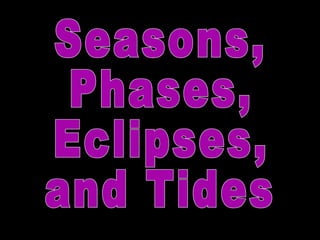
Seasons phases eclipses and tides
- 1. Seasons, Phases, Eclipses, and Tides
- 2. Earth rotates on its axis once every 24 hours. When your part of the earth faces the sun, you experience day. What happens to cause night? Video clip on day and night Rotation
- 3. East West Sun appears to rise in the east and set in the west because the Earth turns on its axis from west to east.
- 4. Revolution The time it takes to make one trip around the sun is a year. That is one revolution. Click here for an animation of a year.
- 5. rotation revolution Hyperlinks to animations of rotation and revolution.
- 6. Leap year It takes 365.24 days for Earth to go around the sun one time. This means we are not at the same place in our orbit as we began. Because of the 0.24 equals about ¼ of a day, we add a day to our calendar every 4 years. Last year (2008) was a leap year so we had a February 29 th . Our next February 29 th will be in 2012.
- 7. Tilt of earth causes seasons. Video clip on seasons
- 8. No tilt – no seasons
- 9. + Summer solstice Winter solstice Links to animations below Solstices
- 12. Many people believe we have summer because we are closer to the sun in the summer. Look at the diagram and explain why they are wrong!
- 13. Bad Astronomy : Only on the day of the Vernal (spring) Equinox, can you stand a raw egg on its end. Good astronomy : If you can stand a raw egg on end, it has nothing to do with the Equinox. How it works : This has to be one of the silliest misconceptions around, and it never seems to die. Every year, without fail, some TV station broadcasts a news segment showing local schoolchildren standing eggs on end on the first day of spring . Usually, the newscaster will make some vague mention about how this works, but it is rarely specific, and never holds up to too much scrutiny.
- 15. Now let's look at the moon.
- 16. The terminator is the moving boundary between day and night. Notice that it moves right to left. The moon does not make its own light. We see it because it reflects light from the sun.
- 17. Daytime on the moon Night on the moon Terminator
- 18. Earthshine What do you notice about this picture? Sometimes you can see part of the moon that is having nighttime.
- 19. Earthshine Sunlight going from sun to moon to earth. Sunlight going from sun to earth to moon and then back to earth. This is called “earthshine.” The earth is acting like a mirror and reflecting some of our sunlight onto the dark part of the moon!
- 20. Phases of the moon are caused by the angle between the earth, moon, and sun.
- 21. Lunar Phase animation Another animation Video clip on phases Notice that the terminator is moving right to left.
- 22. Waxing means getting bigger every night. Waning means getting smaller every night. Crescent means less than half the surface of the moon facing you is lit by the sun. Gibbous means more than half of the surface of the moon facing you is lit by the sun.
- 23. Review this diagram and name the phases on the following slides!
- 24. Waning crescent
- 25. Waxing gibbous
- 26. Waxing crescent
- 27. Last quarter
- 28. Waning crescent
- 29. Waning gibbous
- 30. First quarter
- 31. Eclipses - are named by which object's light is being blocked from your view! Two kinds: Lunar eclipses Solar eclipses Video clip on eclipses
- 32. Lunar eclipse
- 34. Time lapse photography of a lunar eclipse
- 35. Animation of solar eclipse
- 36. Diamond ring effect just before or after a total solar eclipse.
- 37. This animation shows the relative sizes of the partial and total eclipse areas. The small, black dot is the umbra. You can see why not many people ever see a total eclipse.
- 38. This is a space shuttle photograph of an area of the Earth having a total solar eclipse.
- 40. Types of eclipses Link to NASA eclipse page Be sure to scroll down for a list of upcoming eclipses.
- 41. Tides
- 42. This is a review of tides since we studied them already!
- 43. Video clip on tides Watch the change in water level in the Bay of Fundy in Canada. This happens two times a day because there are two high tides and two low tides each day.
- 44. Notice that every six hours there is a high or low tide. If high tide occurs today at 6:00 am in Savannah, GA, what time will be low tide? When will the next high tide occur?
- 45. Because the sun also affects the tides, there are times with the sun and moon work against each other and times when their forces are added together. Video clip on sun and tides
- 46. Notice how phases of the moon affect tides.
- 48. Spring tides Neap tide Notice the moon phases A tide graph.
- 49. Questions?